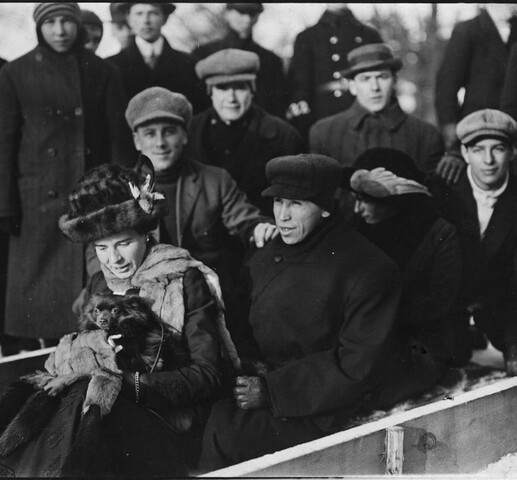
Tom Longboat Runner Plaque
Tom Longboat
Tom Longboat at High Park toboggan hill, Toronto, 1909. Image: City of Toronto Archives
The interior of The Great Hall, 1087-1089 Queen Street West, a property nominated for the 2017 Heritage Toronto Awards.
Detail of pattern-tile ceiling, Longboat Hall, The Great Hall, November 5, 2017. Image by Herman Custodio
Tom Longboat (Onondaga: Gagwe:gih), one of the most famous athletes of the early twentieth century, was an Onondaga long-distance runner from the Six Nations of the Grand River Reserve.
He is regarded as one of Canada’s earliest celebrity athletes, with his athletic achievements renowned throughout North America and beyond. Longboat was a pioneer in developing marathon running as an international sport, winning several marathons in record-breaking times while defeating opponents from all over the world. Additionally, he was the first Indigenous person to win the Boston Marathon in 1907. He represented Canada in the 1908 Olympic Games. Longboat was inducted into both the Canadian and Ontario Sports Halls of Fame. In addition, the Tom Longboat Awards were established in 1951 to celebrate Indigenous athletes for their outstanding contributions to sports in Canada.
Tom Longboat enlisted to serve in World War I at the age of 29. He served as a dispatch carrier with the 107th Pioneer Battalion in France, running messages and orders between stations. He continued to participate in inter-battalion sporting contests, winning many of them. Notably, he won the eight-mile race at the 1918 Canadian Corps Dominion Day competitions. Longboat was wounded twice during his service. There were rumours and instances where he was declared dead, but he survived the war and returned to Canada in 1919.
Longboat’s service in the war highlights the contributions of Indigenous Canadians to our war efforts. Despite facing discrimination and challenges at home, many Indigenous individuals volunteered to serve overseas, exhibiting their dedication and commitment to a country that did not always treat them fairly. Longboat broke barriers in the world of sports, challenging and overcoming racial prejudices of his time.
The commemoration of Tom Longboat aligns with the Truth and Reconciliation Commission’s Calls to Action regarding sports and reconciliation (87-91); however, much more can be done to tell the national story of Indigenous athletes in Canadian history.
Learn more about Tom Longboat at the Heritage Toronto plaque, located outside the Great Hall in Toronto at 1087 Queen Street West, where Longboat trained for the Olympics and Boston Marathon.
Additional Resources:
Six Nations of the Grand River Website
Indigenous Sport & Wellness Ontario (ISWO) Website
Aboriginal Sport Circle Website
North American Indigenous Athletics Hall of Fame

